

Photoshop Text on a Circular Path. Make Type in a Circle to Create a Round Logo in Illustrator. Blackbox 1. 8 Ways To Grow Mentally, Physically, Emotionally & Spiritually. Life these days has become so hectic that it’s very easy for us to get caught up in just trying to “survive” each day.

By “surviving” we’re not referring to making sure we have something to eat and drink each day; “surviving” has become so much more complicated than that. For many people, “surviving” a day means being able to accomplish what others expect of them — “others” being the boss, the spouse, children, parents, friends, and so on. Visual Communication Images with Messages 6th Edition: Bibliography. Visual Communication Images with Messages 6th Edition: BIBLIOGRAPHY A library, to modify the famous metaphor of Socrates, should be the delivery room for the birth of ideas--a place where history comes to life.

Norman Cousins, 1912-1990 AUTHOR, EDITOR, AND HUMANITARIAN Click the title link to find out more about the work or to order it from Amazon.com Chapter 1: Visual Communication Anderson, Steve F. (2011)Technologies of History: Visual Media and the Eccentricity of the PastDartmouth Atzmon, Leslie, Ed. (2011) Visual Rhetoric and the Eloquence of DesignParlor Press. Photography 101 Tutorial: How To Use Shutter Speed. While aperture refers to how narrow or wide a camera’s shutter opens, the shutter speed determines how long it stays open.
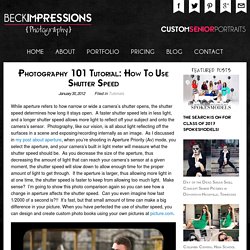
A faster shutter speed lets in less light, and a longer shutter speed allows more light to reflect off your subject and onto the camera’s sensor. Photography, like our vision, is all about light reflecting off the surfaces in a scene and exposing/recording internally as an image. As I discussed in my post about aperture, when you’re shooting in Aperture Priority (Av) mode, you select the aperture, and your camera’s built in light meter will measure what the shutter speed should be. As you decrease the size of the aperture, thus decreasing the amount of light that can reach your camera’s sensor at a given moment, the shutter speed will slow down to allow enough time for the proper amount of light to get through.
If the aperture is larger, thus allowing more light in at one time, the shutter speed is faster to keep from allowing too much light. Canon Explains Exposure. A Little About Exposure: Exposure is the amount of light a digital camera's sensor captures when a photo is taken.
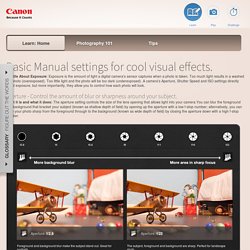
Too much light results in a washed out photo (overexposed). Too little light and the photo will be too dark (underexposed). A camera's Aperture, Shutter Speed and ISO settings directly affect exposure, but more importantly, they allow you to control how each photo will look. ProMonitor Support. BetterPhoto Instructor Insights: Photography Panning for Sports and Action. By Doug Steakley photo copyright by Doug Steakley Panning is the technique of following and photographing a moving subject with a shutter speed that is slow enough to cause the background to blur but fast enough to capture detail in the subject.
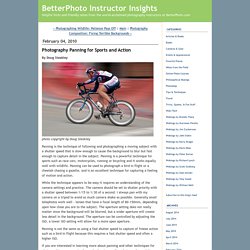
Panning is a powerful technique for sports such as race cars, motorcycles, running or bicycling and it works equally well with wildlife. Diagonal Leading Lines in Photography Composition. Of all the lines used in photography, diagonals are the most dynamic.
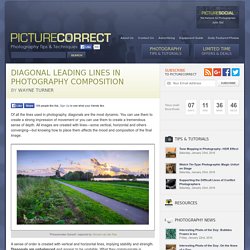
You can use them to create a strong impression of movement or you can use them to create a tremendous sense of depth. All images are created with lines—some vertical, horizontal and others converging—but knowing how to place them affects the mood and composition of the final image. A sense of order is created with vertical and horizontal lines, implying stability and strength. Diagonals are unbalanced and appear to be unstable. What they communicate is dynamic, yet precarious. 52 photography projects: a photo idea to try every week of the year. Taking on a photography project is a great way to get yourself out of a photography rut and to bring some focus to your picture-taking.
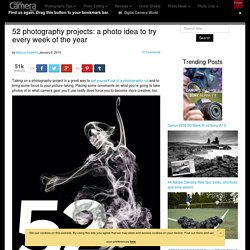
Placing some constraints on what you’re going to take photos of or what camera gear you’ll use really does force you to become more creative, too. We’ve prepared 52 fantastic photo ideas – one for every week in 2015. These are split into three sections: easy home projects you can do today, ideas you can try outdoors at the weekend and a series of ongoing photo projects that you can start now but keep topping up in the coming weeks and months.
URBAN AND ARCHITECTURAL TYPOLOGY OF INDUSTRIAL STRUCTURES VERSUS THEIR PHOTOGRAPHIC TYPOLOGY – A COMPARATIVE ANALYSIS. -1-Tijana Vujičić Abstract: Typology as a scientific discipline and method of research is used extensively in various fields.The contribution of typological research stems fromthe co-action of a number of factors: the phenomenon under consideration, the approach to research, the expression tools used,and theresearcher’s specific goals targeted throughtypology.

Buildings & Structures - TALLIS PHOTOGRAPHY. Raffaele Petralla. Interview with Fine Art Portrait Photographer Bill Gekas. Earlier in the year while surfing through a list of photographers on Google Plus I came across a photograph that grabbed my attention.

A young girl with rosy cheeks, big wide eyes and a serious look on her face stood against a green wallpapered wall dressed in a bright red jacket while holding a bowl of cherries. The image was striking on many levels – the subject, the colour, the pose, the style of the image and what it evoked on an emotional level all caused me to look twice. The photographer was Bill Gekas and a quick look through the rest of his work revealed some beautiful images with a distinct style and attention to detail. Today I’m excited to present an interview with Bill Gekas as well as some of his beautiful images. Bill lives in Melbourne Australia. Current Trends In Portrait Photography World. Portrait photography is one of the most creatively demanding and challenging jobs in the world.

Bringing out the best in your subject by taking a different route and photo ensemble each time and carving a different mood for every client is what makes portraiture unique in its own rights. However, just like other things in the world, trends come and go with the portrait photography landscape as well. Let us have a look at all the trends that are creating some buzz this season. The way we are clicking portraits is changing. Here are a few trends that are here to stay. How to photograph textures. Texture Photography can sometimes be challenging, since composition, light and depth work differently than in, for example, landscape photography. In texture photography, it’s all about patterns, colors and depth, and every single detail of a texture plays a significant role in the overall perception of the photograph. The combination of these intricate details, interesting patterns, vibrant colors and a good depth – all contribute to a beautiful texture. NIKON D700 @ 38mm, ISO 280, 1/100, f/8.0 Here are some tips on photographing textures: 1) Find a texture.
How to Take Better Pictures Using Just the Pop-Up Flash. The dreaded pop-up flash. For many photographers, the thought of using only our built-in flash makes us cringe – and for good reasons. When not carefully altered, the pop-up flash gives off a harsh, direct light that is unnatural. Your photographs will turn out flat every time because the head-on direction of the light erases any shadows that would have added depth or texture. Many times the pop-up flash will overexpose the subject if it is too close in range and the flash intensity is not adjusted accordingly. Such shortcomings are especially apparent when shooting portraits. Introduction to Exposure. Exposure is one of the most basic elements of photography, and most important. In its most basic sense, exposure is how light or dark everything appears in the image. This process begins when light from a source reflects off the objects in your scene.
That light enters your camera through the lens and is absorbed by the sensor. 15283. Quizalize. Assignment 3 – Colour – Research – Ernst Haas. I’ve enjoyed the coursework and exercises for part three and looked forward to planning the assignment. When I first started this TAoP module I dipped into one of the recommended course books Caruana and Fox (2012).
I have now re-visited this book and found the content to be much more relevant. Over the last couple of months it has been slowly dawning on me that by exploring other photographers, both past and present, and their work I can gain both inspiration and knowledge that will help me develop my own practice. Planning for Assignment 3 is probably the first time during this course that I have spent a lot of time reading and researching and I have found that I have enjoyed it very much.
At the start of this section’s coursework I saw Ernst Haas mentioned and was immediately interested in the work of this pioneer of colour photography and wanted to find out more about both Haas and his work. Photographers – On Photography. September 18, 2014 | Leave a Comment | Jay Maisel provides quick candid answers to 20 questions. How do you know when an image doesn’t work? It doesn’t move you in any way.
Repetition is the Mother of all learning. Six Classic Design Elements for Outstanding Photographs. Reading photographs. LEARN NC: Search results. Haiku and photography: A natural connection. Know Yourself Journal Prompts - Google Docs. The Bullet Journal Store. ChasejarvisLIVE: Bravery and Authenticity in a Digital World with Brené Brown with Chase Jarvis. Criticizing Photographs: An Introduction to Understanding Images: Amazon.co.uk: Terry Barrett: 9780072977431: Books. ChasejarvisLIVE: Bravery and Authenticity in a Digital World with Brené Brown with Chase Jarvis.
The Main Idea Visible Learning for Teachers April 2013. Find and share online flashcards and notes from StudyBlue. Any subject, anywhere, anytime. 50 Great Ways to Grow Your Personal Learning Network. How to Start a Blog - The Free Guide (+ PDF & Audiobook) 20% Philosophy Meets Blogging.
Professional Development. Find me on Twitter @Catlin_Tucker. Blended Learning Explained by Common Craft. Common Craft. Patricia Forrest Blending In Review Video. Lewisham Southwark College. PKM in 40 Days. Why PKM? Taking Blended Learning to the Next Level by Catherine Lombardozzi. CJKoh. New eLearning Guild Academy Course: Advanced Blended Learning: Learning Environments by Design by Janet Clarey. Blended learning at mit. The Social Catch-up - Shortie Designs. Three Ed-Tech Trends Showing Why Mobile Learning is On the Rise. 10 Typography Nightmares to Avoid. Google. BH027165-HNCD-Art-and-Design-Units-Issue5. Nottingham Trent University. Three British Girls Go To Syria To Become Jihadists - Russell Brand Asks Why?